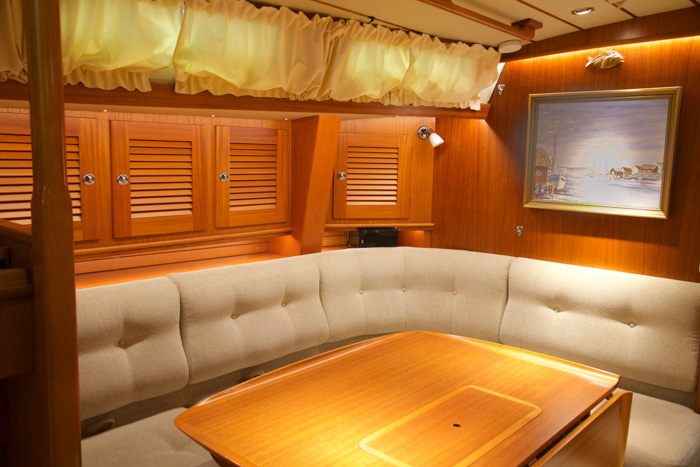dim2warm

There is nothing more cozy than an oil lamp onboard

The answer is thus found in the colour temperature of the light. This is measured in Kelvin.
Direct sunlight has 6,000 Kelivn and is considered being a “cold bright light”. It’s made for waking up in the morning and working during daytime. It keeps you awake and focused on your work. Cold sunlight is therefore great during daytime.

The galley during day-light. Great for focused work. Observe that the indirect light under the cupboards are switched on, despite daytime. This is in order to illuminate darker areas creating a feeling of space. The bright white glass tiles help as well, of course. The indirect light has 3,000K and mixes well with the sunlight.
When the sun is slowly moving towards the horizon, it gets time to switch on your cabin lights.
Now, it’s great to create a “warm-white” light of some 3,000 Kelvin. This light temperature still keeps you awake, gives you focus to do leisure activities, read and cook. 3,000 K is also ideal for indirect light when it shines onto the interior wood, like the beautiful mahogany, which, per se, is very red and reflects a very warm light.

In the early evening it’s great to have some 3,000K. The indirect light is reflecting the true red cozy colours of the mahogany wood. The nature of wood creates the warmth. Thanks to the CRI 95 of the LED tapes and the ceiling lights shine up the walls, table and painting. From here, the light is turned warm and reflects the cozy warm natural colour of the wood.
When working with indirect light, it is very important to allow the true colours to come to live. Otherwise the reddish tints of the beautiful mahogany would not give the desired cozy and warm atmosphere. The true colours of the painting, the cupboards with the beautifully handcrafted louvre doors or the salon table can only be reflected correctly if the LED light sources have a high Colour Rendering Index (CRI). Here, the LEDs have a CRI of 95 which is about the best on the market.

LED tapes shine onto the wood which then – indirectly – lights up the cabin in the true cozy colours of the mahogany.
3,000 Kelvin is a good warm-white light which is perfect for indirect light, even when time moves on towards evening and it finally becomes time for that very warm oil-lamp-style of light.
Around sunset, it’s time to dim down the lights onboard. Contrary to traditional light bulbs, most LEDs keep their colour temperature throughout the dimming process, unfortunately. This means, an LED with light sources of 3,000K keep this colour temperature, even when it’s dimmed down.
Now, for indirect light, such as tapes and spot-lights in the ceiling shining on wood, this is completely acceptable. (This would be different, of course, if the LED would reflect against a white wall. If so, the reflected light might be considered as too cold. But with a beautiful wooden interior, it’s the colour of the wood that counts! Other types of wood have a different colour, by the way, even a green tint, yellow or greyish).
Having said this, with a light source directly visible to your eyes this is different! With no reflection, the light reaches directly into your eyes, just as with that wonderful oil lamp, candle or open camp fire.
When you can see the light source directly with your eyes, we would benefit from seeing a warmer light source when you dim down at night, just like when we enjoy looking into the warmth of an oil lamp. The more the lamp is dimmed down, the more it should shine warmer, simulating a traditional light bulb. Reading and wall lamps with any kind of translucent light shade ideally needs to become warmer the more they are dimmed down.
Also beside reading lamps over berths benefit from becoming warmer at bed-time to help falling a good night’s sleep.

German light manufacturer Prebit has now come up with a new unique solution for the marine industry called dim2warm®! Fully turned up, they have the desired 3,000 Kelvin, while dimmed down, the warmth goes all the way to 2,200 Kelvin which is a wonderful warm light.
The difficulty lies in controllling various types of LEDs, each with individual light temperatures and then mixing the light sources according to desire. With Prebit the transition from colder to warmer light is smooth, even and stepless, wich is a great feature of this light.
See the stepless dimming and simultaneous change in colour tempearutre on the below video!
These hand-crafted lamps are built to the highest of quality standards. No wonder they are also supplying the superyacht industry as well as demanding owners of the high end boat brands! You find them on Sirius Yachts , Faurby Yachts, Scalar, as well as Hallberg-Rassy Yachts and many more. See examples here.
The Prebit R1-1 wall lights are, by the way, being installed on Regina Laska for the upcoming season of 2025. Prebit-lights are designed and manufactured in Germany.
There should be no reason they couldn’t be installed on your boat as well. Definitely not the cheapest lights, but since you only need typically four lights in the salon to create that perfect atmosphere any time during the day, they might be just the right investment for a good enriched feeling, enhancing the value of your boat at the same time.

Having said all this, there is nothing that beats that good old-fashioned classic oil lamp! But sometimes, you are just too lazy to bring it out, fill it up and lit it, or you just don’t fancy a burning open flame inside, consuming oxygen and producing moisture in your cabin…
For me, I love an oil lamp outside in the cockpit, while down below, we will enjoy Prebit’s new dim2warm lights in the future.

